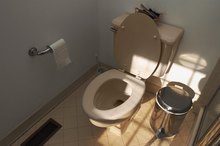What does fact checked mean?
At Healthfully, we strive to deliver objective content that is accurate and up-to-date. Our team periodically reviews articles in order to ensure content quality. The sources cited below consist of evidence from peer-reviewed journals, prominent medical organizations, academic associations, and government data.
The information contained on this site is for informational purposes only, and should not be used as a substitute for the advice of a professional health care provider. Please check with the appropriate physician regarding health questions and concerns. Although we strive to deliver accurate and up-to-date information, no guarantee to that effect is made.
Squatting Exercise for Bladder Prolapse
Bladder prolapse is a common condition among women who've had vaginal childbirths - as if childbirth isn't hard enough! Characterized by a sagging bladder that causes pain and urinary problems, it can also result from chronic cough, frequent constipation and straining to pass stool and obesity.
Strengthening the pelvic floor muscles is the main treatment prescription for mild cases 3. While squats are often touted as beneficial for this goal, several types of squats can be unsafe for those experiencing bladder prolapse.
What's Going on With a Prolapsed Bladder?
In order to understand the exercises that are safe when you have a prolapsed bladder, it helps to understand a little bit about what's going on in your body.
A healthy bladder is held in place by a "hammock" of muscles and ligaments. Stresses such as multiple vaginal births or the prolonged pressure from coughing or straining to have a bowel movement gradually weakens these supportive structures, allowing the bladder to sag through the layers of muscles and ligaments. As this occurs, the bladder bulges into the vagina.
It's safe to say that anything that puts more pressure on these weakened muscles is a no-go.
- In order to understand the exercises that are safe when you have a prolapsed bladder, it helps to understand a little bit about what's going on in your body.
- A healthy bladder is held in place by a "hammock" of muscles and ligaments.
Squatting With a Prolapsed Bladder
What Exercises Can I Do So I Won't Tear During Labor?
Learn More
- Wide-stance barbell squats
- Wide-stance dumbbell squats
- Kettlebell squats
- Body weight squat jumps
:
Modifying Squats to Make Them Safer
- Position your feet no wider than hip-distance apart. * Keep your torso upright, and contract your core muscles to protect your lower back.
- Do not hold your breath while squatting. Inhale as you squat down and exhale as your rise back up.
- Keep your hips higher than your knees throughout the exercise to avoid pressure on your pelvic floor. This will also protect your knees and your lower back.
- Before and during your squat, try to activate your pelvic floor muscles. To do this, squeeze your pelvic floor muscles as if you are hold back urine.
- Keep your lower back neutral, neither rounding or arching.
:
-
- Position your feet no wider than hip-distance apart.
- Position your feet no wider than hip-distance apart.
-
* Keep your hips higher than your knees throughout the exercise to avoid pressure on your pelvic floor.
Related Articles
References
- Harvard Health Publishing: Uterine And Bladder Prolapse
- Pelvic Exercises: 7 Unsafe Exercises for Women with Prolapse & after Prolapse Surgery
- Pelvic Exercises: How to Squat – Physiotherapist Video for Pelvic Floor Safe Leg Strengthening
- Jessie Mundell: Prolapse Safe Exercise
- Girls Gone Strong: Can I Exercise With Pelvic Organ Prolapse?
- Chiarelli, Pauline, Women's Waterworks: Curing Incontinence. Wallsend NSW Australia: George Parry. 2002.
- Pelvic Floor Muscle Training Exercises. MedlinePlus. Dec 2014.
Writer Bio
Jody Braverman is a professional writer and editor based in Atlanta, GA. She received a Bachelor of Arts in English from the University of Maryland, and she is a certified personal trainer, fitness nutrition specialist, and yoga teacher. She has written for various online and print publications, including Livestrong.com, SFGate, Healthfully, and Chron.com. Visit the writer at www.JodyBraverman.com.









